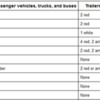Agreed, but the timing will likely be off, in other words the flash rate will likely not be the same with AC as on DC for the same voltage (nominally 12 V). I'm thinking it would need in about 17 VAC to match.
Curious as to your reasoning. My reasoning is a traditional bimetal thermal strip warms up through resistive heating, bends to make/break electrical contact, cools, bends back to break/make electrical contact, lather-rinse-repeat.
A resistor is agnostic to whether the applied voltage is AC or DC. So 12V DC and 12V AC should heat it equally well and the timing should be identical.
Based on the somewhat "loose" specs, I do think this is an old-school thermal strip type flasher. It is almost inconceivable that an electronic (digital) implementation would have a flash rate that might be from 60 - 120 flashes per minute...and have a duty-cycle that might be from 35%-75%.

I would fully expect an "electronic" implementation to require DC voltage.
...Could get a bridge rectifier but cost goes up.
If the purpose of the bridge rectifier is to convert AC to DC...then the output of the bridge rectifier will not be "flat" constant DC like you'd expect from a battery. The DC would be "pulsed" DC with peaks and valleys like the original AC voltage. I can't imagine this would change the behavior of a thermal bimetal strip flasher...other than you'd lose about 1 Volt going thru the bridge.
I realize it's easy for me to say to just hook it up to train transformer accessory AC and see what happens. 
Separately, while not as simple to hook up as the 3-prong wig-wag automotive flasher, I've previously posted many ways to wig-wag flash the 154 if you're comfortable with some DIY wiring and such. For example, this OGR thread had the following video for a 154 flasher for less than $10. It's digital so you can program the flash rate to EXACTLY 60.0 flashes per minute...or 60.1 flashes per minute...etc. Or you can program the duty cycle to be EXACTLY 50% so that each lamp is on exactly half the time. Of course you still have the issue of the clicking relay sound though the automotive flasher presumably has a similar clicking sound.


















